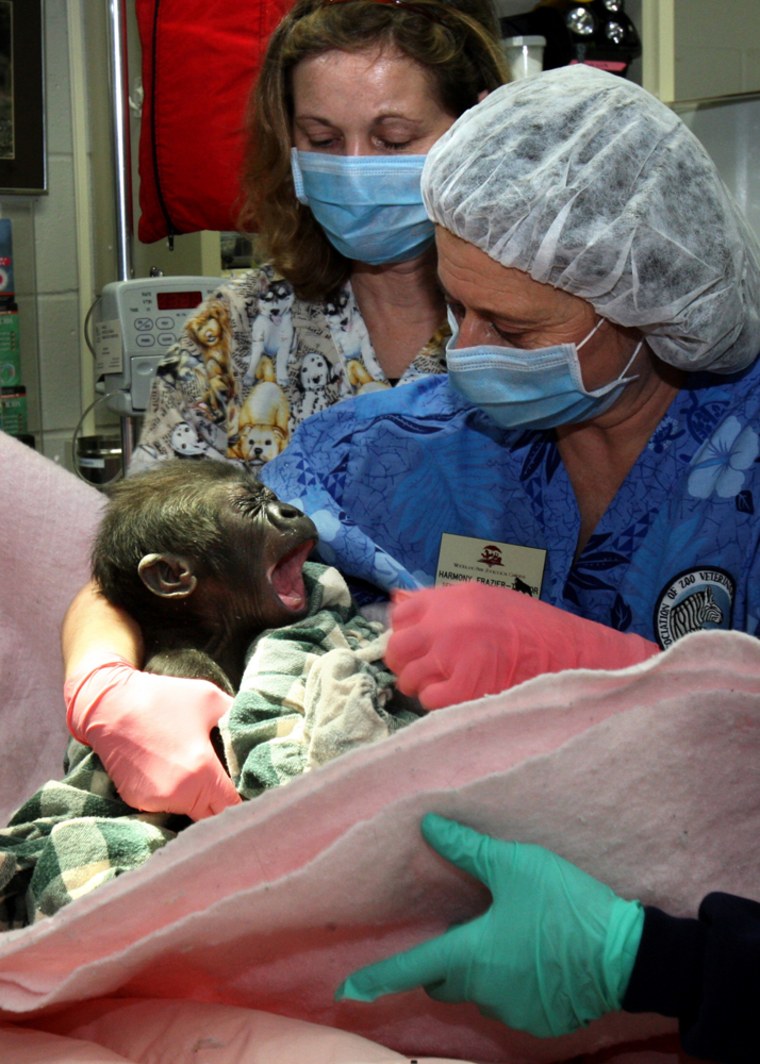Veterinarians and pediatric surgeons combined their efforts to remove a cyst near the spine of a baby gorilla at the Woodland Park Zoo, an operation they believe is the first of its kind.
During the hourlong operation Thursday morning at the zoo, surgeons from Children's Hospital and Regional Medical Center joined zoo vets in removing the mass, which was 1.2 to 1.6 inches (3 to 4 centimeters), said Dr. Richard G. Ellenbogen, a neurosurgeon and chairman of the department of neurological surgery at the University of Washington, which is affiliated with the hospital.
The surgery also confirmed that the as-yet-unnamed baby gorilla has a mild case of spinal bifida, which doctors said should not be a concern as she grows older.
"This gorilla operation was an amazing 'Star Trek' type of experience for the team from Children's and the UW," Ellenbogen said.
The baby, the 12th successful gorilla birth for the zoo and the third offspring of Amanda, 37, and the father, Vip, 28, arrived in October with the cyst at the base of her back, but because of the way gorillas hold their babies it was some time before the deformity was noticed.
Experts hoped to wait until the gorilla was a bit older and could tolerate surgery better but grew concerned as recent tests showed it had become infected and was growing toward the spine, raising a risk of meningitis, said Dr. Kelly E. Helmick, the zoo's interim director of animal health.
Before the surgery, zookeepers trained the mother, Amanda, to carry her baby to them so they could give antibiotics to help fight the infection, Helmick said.
After the operation, the gorilla was placed on a table outside of the operating room to be given fluids and kept warm in a large pink blanket while awakening from the anesthesia. About 30 minutes later, the creature yawned and opened her eyes, her pink and purple pacifier at the ready and a small stuffed gorilla on the counter nearby.
As soon as zookeepers returned her to Amanda, the mother grabbed the infant and began nursing, Helmick said.
"It was a touching reunion between mom and baby," she said.
Gorillas naturally pick at each other to remove dirt and insects, so the sutures were buried under the skin and covered with surgical tissue glue, while Amanda's nails were painted red so she would be distracted and pick at her nails instead of at her baby's incision.
Recovery is expected to take up to two weeks and the prognosis is good, Helmick said.
Ellenbogen and other hospital personnel donated their time and Integra LifeSciences, a medical instrument company in Plainsboro, N.J., donated nearly $60,000 worth of spinal instruments to the zoo for the surgery.
Children's Hospital has about two to five cases a year similar to the one in the baby gorilla, Ellenbogen said.
"What we were able to do here was parallel to what we do in the human world," he said. "We were prepared for the worst and it turned out to be something we could treat and cure."
